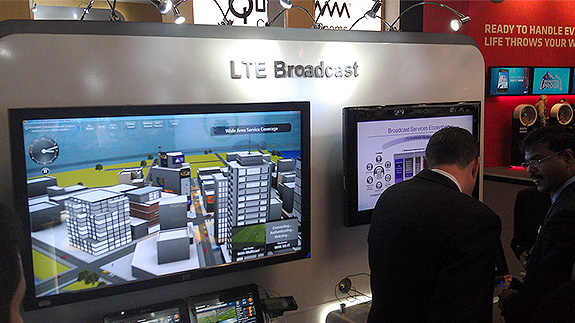Ericsson debuts “wireless broadcast” delivery over 4G networks
Ericsson demonstrated a trio of new IP-based streaming technologies at the 2013 Mobile World Congress in Barcelona, Spain, that allow mobile carriers to launch broadcast video delivery over mobile networks. The technologies, known as Evolved Multimedia Broadcast Multicast Service (eMBMS), HEVC and MPEG DASHG streamline the delivery of content in the most cost-effective and efficient way.
The company said Verizon Wireless would introduce LTE Broadcast for entertainment and sporting events in the United States beginning early next year. Mobile network operator Telstra in Australia will also begin trials on its live network later this year.

What’s different this time is the Ericsson technology is true “broadcast“ video, meaning a single stream sent to many viewers simultaneously. This eliminates the pause-rewind-skip functions users now get while watching mobile video on YouTube or other video-on-demand services.
Verizon and Ericsson have both said they think mobile users will forgo the convenience of being able to control playback for the increased network efficiency made possible by the new video technology.
The eMBMS system uses existing cellular infrastructure, and radio frequencies, but broadcasts the same signal to any number of people. This makes it far more efficient, as long as users want to download the same content at the same time.
HEVC (High Efficiency Video Coding) is the new video compression standard that promises to half the bandwidth required to transport video content.
MPEG DASH (Dynamic Adaptive Streaming over HTTP) simplifies and standardizes the adaptive delivery of video to consumer devices, ensuring a better quality of service, greater efficiency and opening opportunities for monetization.
Ericsson said that 67 per cent of viewers watch TV on a mobile device or tablet. But they don’t say how many would choose to do so if they couldn’t select what to watch, the Register reported.
The launch of the Verizon technology will be early next year and will center on sporting events and concerts. That’s time-critical content that will certainly need the bandwidth available to the 4G-based eMBMS, along with the greater compression that H.265 can offer and the adaptive capabilities of MPEG DASH, which can modify the encoding to suit the available bandwidth.
Ericsson said TV and video traffic is set to dominate networks and grow from 40 percent to 90 percent of mobile traffic within the next four years. However, the Register pointed out that just because something is technically possible doesn’t mean paying customers will want it.
Broadcasting television to mobile telephones has been tried before, it reported, and tried again — eating through millions of dollars and pushing the technical development to almost universal indifference from consumers who just want a program service to work properly.
Verizon said its 4G LTE network is now in 470 markets in the United States.
Get the TV Tech Newsletter
The professional video industry's #1 source for news, trends and product and tech information. Sign up below.
